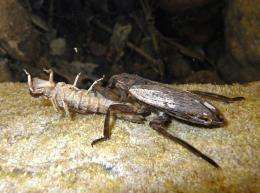Severe drought, other changes can cause permanent ecosystem disruption

(PhysOrg.com) -- An eight-year study has concluded that increasingly frequent and severe drought, dropping water tables and dried-up springs have pushed some aquatic desert ecosystems into “catastrophic regime change,” from which many species will not recover.
The findings, just published in the journal Freshwater Biology, raise concerns that climate change, over-pumping of aquifers for urban water use, and land management may permanently affect which species can survive. The research was supported by the National Science Foundation.
“Populations that have persisted for hundreds or thousands of years are now dying out,” said David Lytle, an associate professor of zoology at Oregon State University. “Springs that used to be permanent are drying up. Streams that used to be perennial are now intermittent. And species that used to rise and fall in their populations are now disappearing.”
The research, done by Lytle and doctoral candidate Michael Bogan, examined the effect of complete water loss and its subsequent impact on aquatic insect communities in a formerly perennial desert stream in Arizona’s French Joe Canyon, before and after severe droughts in the early 2000s.
The stream completely dried up for a period in 2005, and again in 2008 and 2009, leading to what researchers called a rapid “regime shift” in which some species went locally extinct and others took their place. The ecosystem dynamics are now different and show no sign of returning to their former state. Six species were eliminated when the stream dried up, and 40 others became more abundant. Large-bodied “top predators” like the giant waterbug disappeared and were replaced by smaller “mesopredators” such as aquatic beetles.
“Before 2004, this area was like a beautiful oasis, with lots of vegetation, birds and rare species,” Lytle said. “The spring has lost a number of key insect species, has a lot less water, and now has very different characteristics.”
The phenomena, the researchers say, does not so much indicate the disappearance of life – there is about as much abundance as before. It’s just not the same.
“Our study focused on a single stream in isolation, but this process of drying and local extinction is happening across the desert Southwest,” Bogan said. “Eventually this could lead to the loss of species from the entire region, or the complete extinction of species that rely on these desert oases.”
Small streams such as this are of particular interest because they can be more easily observed and studied than larger rivers and streams, and may represent a microcosm of similar effects that are taking place across much of the American West, the researchers said. The speed and suddenness of some changes give species inadequate time to adapt.
“It’s like comparing old-growth forests to second-growth forests,” Lytle said. “There are still trees, but it’s not the same ecosystem it used to be. These desert streams can be a window to help us see forces that are at work all around us, whether it’s due to climate change, land management or other factors.”
The researchers noted in their report that the last 30 years have been marked by a significant increase in drought severity in the Southwest. The drought that helped dry up French Joe Canyon in 2005 resulted in the lowest flow in Arizona streams in 60 years, and in many cases the lowest on record. At French Joe Canyon, the stream channel was completely dry to bedrock, leaving many aquatic invertebrates dead in the sediments.
That was probably “an unprecedent disturbance,” the researchers said in their report. Community composition shifted dramatically, with longer-lived insects dying out and smaller, shorter-lived ones taking their places.
Conceptually similar events have taken place in the past in plant communities in the Florida Everglades, floodplains in Australia, and boreal forests following fire disturbance, other researchers have found. In the Southwest, climate change models predict longer, more frequent and more intense droughts in the coming century, the scientists noted in their study.
Provided by Oregon State University



















